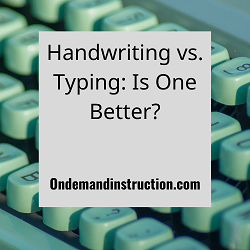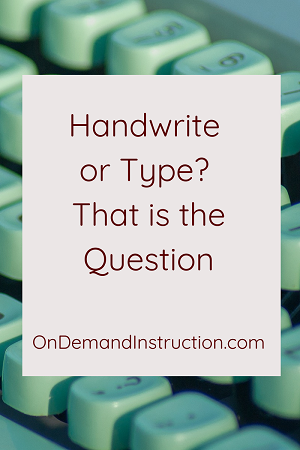 What do Barack Obama, Joyce Carol Oates, Neil Gaiman, and Tom Wolfe have in common? They all write their books by hand- yes, by hand with pen and paper. Today, we have become so dependent on keyboards that we have lost the art behind handwriting, and it could be affecting our creativity. I remember senior year of high school. I submitted a ten-page research paper that was handwritten, in what was then, pretty decent penmanship. I didn’t have access to a typewriter, and although my high school had word processors and computers for students to use, I had no idea how to use one. My teacher said penmanship made her eyes hurt and told me it was the last paper she’d accept in longhand. My determination to stick with pen and paper lasted me through college, as I wrote out every essay by hand before typing it on a 1960s typewriter in freshman and sophomore years before I upgraded to a word processor. For me, I couldn’t compose at the keyboard; I needed a pen in my hand (and a cup of coffee in the other) to get the words flowing. During class one day, a professor asked questions about the writing process, and I shared my experience of combining both longhand and typed steps to create a piece. She was clearly shocked and recommended I practice composing at the keyboard to save time. Learning to think and type at the same time took me years, and once I did, guess what happened? My handwriting became illegible, I started writing longer pieces more quickly, and I lost some of the joy of writing. As a Gen Xer, my experience has similarities to others my age, but younger people never combined the two styles of writing and have written exclusively on a keyboard their entire lives. Does it really make a difference how we write? Actually, it can. When we write by hand, we can go through a different creative experience than when we type, and the pieces we produce can be different. When we write longhand, the process of composing sentences is slowed because we tend to handwrite slower than we type. This slowing changes the creative process, because it allows the mind to connect ideas, ask connected questions, and think through other ideas before writing the next sentence. While working with creative ideas, writers who handwrite can make interesting connections to drive their stories forward. This could increase productivity and lessen the likelihood of the dreaded writer’s block. As well, handwriting is visual in a way that typing never can be. We are a highly visual society, so being able to see our words composed on the page can reinforce our confidence with the creative process. It also allows for the option of doodling and drawing in the margins, which can put a visual to a story. And it can allow us to edit directly on the page so that we can still see the original words; whereas typing deletes the typed words and leaves us only with the current version of the text. Being able to see the words on the page at various editing stages can help the writer stay connected to the story and build on its intricacies over time. Educational research shows that handwriting helps writers process information. We learn more, we understand more, and we are able to make more connections when we take notes and write by hand. If there is anything writers need when they are composing it is to be able to learn, understand, and make connections. As well, we are more likely to tap into another layer of creativity when we write by hand, because penmanship itself is an art form. If you remember people talking about identifying a person’s qualities by analyzing their handwriting, then you’ll remember how important the artfulness of penmanship can be. The admirable attributes of handwriting don’t end there. Happily, the world has yet to connect Facebook, Google, or other writer-distracting apps to paper. Many writers today admit they are easily distracted while writing and don’t produce as much quality work as they would like to. Well, if you can reconnect with pen and paper, you may be able to leave social media’s endless scrolling behind during your creativity time. So, is typing really so bad? Not really, no. Many writers choose the keyboard for a variety of reasons including: comfort, composition speed, and combining the writing process steps. I’ve met more than a few people whose hands hurt when they handwrite, so using a keyboard is more comfortable for them. Too, writers have the ability to compose longer pieces at the keyboard in shorter periods of time (as long as they stay focused and are quick typists). As well, writers have also reported that they can type up an outline of their ideas and use that to type up the paragraphs. Whether it’s a short story, an essay, or a novel, using a word processing document to move from one stage to the next can lessen the work and help writers stay organized. If you are a writer who loses everything from your keys to Post-it Notes, carrying around stacks of paper might be a bad idea. But, if you have a secure backup system with your computer, then typing may be the best solution so that you don’t lose your work. Is there a solution?
Oh sure, do what works best for you. Part of the process of being a creative person is finding out which processes support your creativity. You may need to try out multiple methods before landing on your best practice. Perhaps you brainstorm and outline with typing then handwrite the draft and type the final version into your computer. One of the most valuable realizations about my own writing process happened while I was reading Stephen King’s On Writing. In that book, he discussed his process, which includes writing out the first draft then cutting 20% of the words to create the second draft. While reading that, I realized that my process was completely different, because I write a small rough draft, then I double the words on my second draft, and double again on the third draft, and so on. Knowing what works for you solves a plethora of potential problems and gives you confidence in your own creativity. If it’s going to be pen and paper or the keyboard for you, just make sure the process suits your creative needs. |
About the SiteWelcome, Writers! Archives
September 2023
|



 RSS Feed
RSS Feed